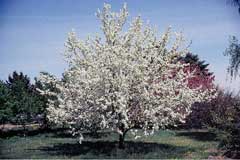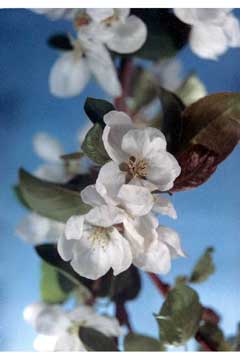 |
|
USDA-NRCS PLANTS Database / Herman, D.E., et al. 1996. North Dakota tree handbook. USDA NRCS ND State Soil Conservation Committee; NDSU Extension and Western Area Power Administration, Bismarck. |
 |
| USDA-NRCS PLANTS Database / Herman, D.E., et al. 1996. North Dakota tree handbook. |
Translate this page:
Summary
Physical Characteristics
![]()
![]() Malus praecox is a deciduous Tree.
Malus praecox is a deciduous Tree.
It is not frost tender. The species is hermaphrodite (has both male and female organs) and is pollinated by Insects.
It is noted for attracting wildlife.
Suitable for: light (sandy), medium (loamy) and heavy (clay) soils, prefers well-drained soil and can grow in heavy clay soil. Suitable pH: mildly acid, neutral and basic (mildly alkaline) soils. It can grow in semi-shade (light woodland) or no shade. It prefers moist soil.
UK Hardiness Map
US Hardiness Map
Synonyms
Plant Habitats
Woodland Garden Secondary; Sunny Edge; Dappled Shade;
Edible Uses
Edible Parts: Fruit
Edible Uses:
Fruit - raw or cooked[105]. A sweet flavour[61].
References More on Edible Uses
Medicinal Uses
Plants For A Future can not take any responsibility for any adverse effects from the use of plants. Always seek advice from a professional before using a plant medicinally.
None known
References More on Medicinal Uses
The Bookshop: Edible Plant Books
Our Latest books on Perennial Plants For Food Forests and Permaculture Gardens in paperback or digital formats.

Edible Tropical Plants
Food Forest Plants for Hotter Conditions: 250+ Plants For Tropical Food Forests & Permaculture Gardens.
More

Edible Temperate Plants
Plants for Your Food Forest: 500 Plants for Temperate Food Forests & Permaculture Gardens.
More

More Books
PFAF have eight books available in paperback and digital formats. Browse the shop for more information.
Shop Now
Other Uses
References More on Other Uses
Cultivation details
An easily grown plant, it succeeds in most fertile soils, preferring a moisture retentive well-drained loamy soil[1, 200]. Grows well in heavy clay soils. Prefers a sunny position but succeeds in partial shade though it fruits less well in such a situation[1, 200]. This species is a parent of the cultivated apple[11] and it is cultivated in the Mediterranean for its edible fruit[61]. The fruit is a good wildlife food source, especially for birds[200]. Hybridizes freely with other members of this genus[200]. Plants in this genus are notably susceptible to honey fungus[200].
References Carbon Farming Information and Carbon Sequestration Information
Temperature Converter
Type a value in the Celsius field to convert the value to Fahrenheit:
Fahrenheit:
The PFAF Bookshop
Plants For A Future have a number of books available in paperback and digital form. Book titles include Edible Plants, Edible Perennials, Edible Trees,Edible Shrubs, Woodland Gardening, and Temperate Food Forest Plants. Our new book is Food Forest Plants For Hotter Conditions (Tropical and Sub-Tropical).
Shop Now
Plant Propagation
Seed - best sown as soon as it is ripe in the autumn in a cold frame. It usually germinates in late winter. Stored seed requires stratification for 3 months at 1°c and should be sown in a cold frame as soon as it is received[200]. It might not germinate for 12 months or more. Prick out the seedlings into individual pots as soon as they are large enough to handle. If given a rich compost they usually grow away quickly and can be large enough to plant out in late summer, though consider giving them some protection from the cold in their first winter. Otherwise, keep them in pots in a cold frame and plant them out in late spring of the following year. Cuttings of mature wood, November in a frame[11].
Other Names
If available other names are mentioned here
Native Range
EUROPE: Austria, Czech Republic, Hungary, Slovakia, Russian Federation-European part (European part (south)), Albania, Bulgaria, Greece, Croatia, North Macedonia, Romania, Serbia, Slovenia
Weed Potential
Right plant wrong place. We are currently updating this section.
Please note that a plant may be invasive in one area but may not in your area so it's worth checking.
Conservation Status
IUCN Red List of Threatened Plants Status :

| Related Plants
|
| Latin Name | Common Name | Habit | Height | Hardiness | Growth | Soil | Shade | Moisture | Edible | Medicinal | Other |
| Malus angustifolia | Southern Crab, Southern crab apple | Tree | 7.0 |
3-8
| M | LMH | SN | M | 2 | 0 | 2 |
| Malus baccata | Chinese Crab, Siberian crab apple | Tree | 15.0 |
2-7
| M | LMH | SN | M | 2 | 1 | 2 |
| Malus baccata mandschurica | Manchurian Apple | Tree | 7.0 |
0-0
| | LMH | SN | M | 4 | 0 | 2 |
| Malus bracteata | | Tree | 7.0 |
5-9
| | LMH | SN | M | 2 | 0 | |
| Malus brevipes | | Tree | 3.0 |
4-8
| | LMH | SN | M | 2 | 0 | |
| Malus coronaria | Garland Crab, Sweet crab apple | Tree | 7.0 |
4-8
| | LMH | SN | MWe | 3 | 1 | 3 |
| Malus domestica | Apple | Tree | 9.0 |
3-8
| M | LMH | SN | M | 5 | 2 | 4 |
| Malus florentina | Hawthorn-leaf crab apple | Tree | 8.0 |
4-8
| | LMH | SN | MWe | 2 | 0 | |
| Malus floribunda | Japanese Crab, Japanese flowering crab apple | Tree | 10.0 |
4-7
| M | LMH | SN | M | 3 | 0 | |
| Malus fusca | Oregon Crab, Oregon crab apple | Tree | 12.0 |
5-9
| S | LMH | SN | M | 3 | 2 | 2 |
| Malus glabrata | | Tree | 5.0 |
5-9
| | LMH | SN | M | 2 | 0 | |
| Malus glaucescens | | Tree | 5.0 |
4-8
| | LMH | SN | M | 2 | 0 | 1 |
| Malus halliana | Hall crab apple | Tree | 4.0 |
4-8
| | LMH | SN | M | 2 | 0 | |
| Malus halliana spontanea | | Tree | 4.0 |
4-8
| | LMH | SN | M | 2 | 0 | |
| Malus hupehensis | Chinese Crab, Chinese crab apple, Tea Crabapple, Flowering Tea Crabapple | Tree | 7.0 |
4-8
| M | LMH | SN | M | 2 | 0 | 2 |
| Malus ioensis | Prairie Crab, Prairie crab apple, Texas crab apple, Prairie Crabapple | Tree | 5.0 |
3-8
| S | LMH | SN | M | 2 | 0 | 2 |
| Malus ioensis palmeri | Prairie Crab | Tree | 5.0 |
-
| | LMH | SN | M | 2 | 0 | |
| Malus kansuensis | | Tree | 5.0 |
4-8
| | LMH | SN | M | 2 | 0 | |
| Malus lancifolia | | Tree | 6.0 |
4-8
| | LMH | SN | M | 2 | 0 | 1 |
| Malus prattii | Pratt apple | Tree | 10.0 |
5-9
| | LMH | SN | M | 2 | 0 | |
| Malus prunifolia | Chinese Apple, Plumleaf crab apple | Tree | 8.0 |
3-7
| | LMH | SN | M | 4 | 0 | 1 |
| Malus prunifolia rinkii | Chinese Apple | Tree | 8.0 |
3-7
| | LMH | SN | M | 3 | 0 | |
| Malus pumila | Paradise Apple, Common Apple, Apple Tree | Tree | 7.0 |
3-9
| M | LMH | SN | M | 4 | 2 | 3 |
| Malus pumila nervosa | Crab Apple | Tree | 5.0 |
3-7
| | LMH | SN | M | 3 | 0 | 2 |
| Malus pumila paradisiaca | Paradise Apple | Tree | 5.0 |
3-7
| | LMH | SN | M | 3 | 0 | 2 |
| Malus sargentii | Sargent's apple, Sargent Crabapple | Shrub | 4.0 |
4-8
| S | LMH | SN | M | 2 | 0 | |
| Malus sieversii | Crabapple | Tree | 8.0 |
4-10
| | LMH | SN | M | 3 | 0 | 0 |
| Malus sikkimensis | | Tree | 7.0 |
5-9
| | LMH | SN | M | 2 | 0 | |
| Malus spectabilis | Chinese Flowering Apple, Asiatic apple | Tree | 9.0 |
4-8
| | LMH | SN | M | 3 | 0 | |
|
|
Growth: S = slow M = medium F = fast. Soil: L = light (sandy) M = medium H = heavy (clay). pH: A = acid N = neutral B = basic (alkaline). Shade: F = full shade S = semi-shade N = no shade. Moisture: D = dry M = Moist We = wet Wa = water.
Now available:
Food Forest Plants for Mediterranean Conditions
350+ Perennial Plants For Mediterranean and Drier Food Forests and Permaculture Gardens.
[Paperback and eBook]
This is the third in Plants For A Future's series of plant guides for food forests tailored to
specific climate zones. Following volumes on temperate and tropical ecosystems, this book focuses
on species suited to Mediterranean conditions—regions with hot, dry summers and cool, wet winters,
often facing the added challenge of climate change.
Read More
Expert comment
Author
(Pall.)Bork.
Botanical References
1174
Links / References
For a list of references used on this page please go here
Readers comment
| Add a comment |
|
If you have important information about this plant that may help other users please add a comment or link below. Only comments or links that are felt to be directly relevant to a plant will be included. If you think a comment/link or information contained on this page is inaccurate or misleading we would welcome your feedback at [email protected]. If you have questions about a plant please use the Forum on this website as we do not have the resources to answer questions ourselves.
* Please note: the comments by website users are not necessarily those held by PFAF and may give misleading or inaccurate information.
To leave a comment please Register or login here All comments need to be approved so will not appear immediately.
|
|